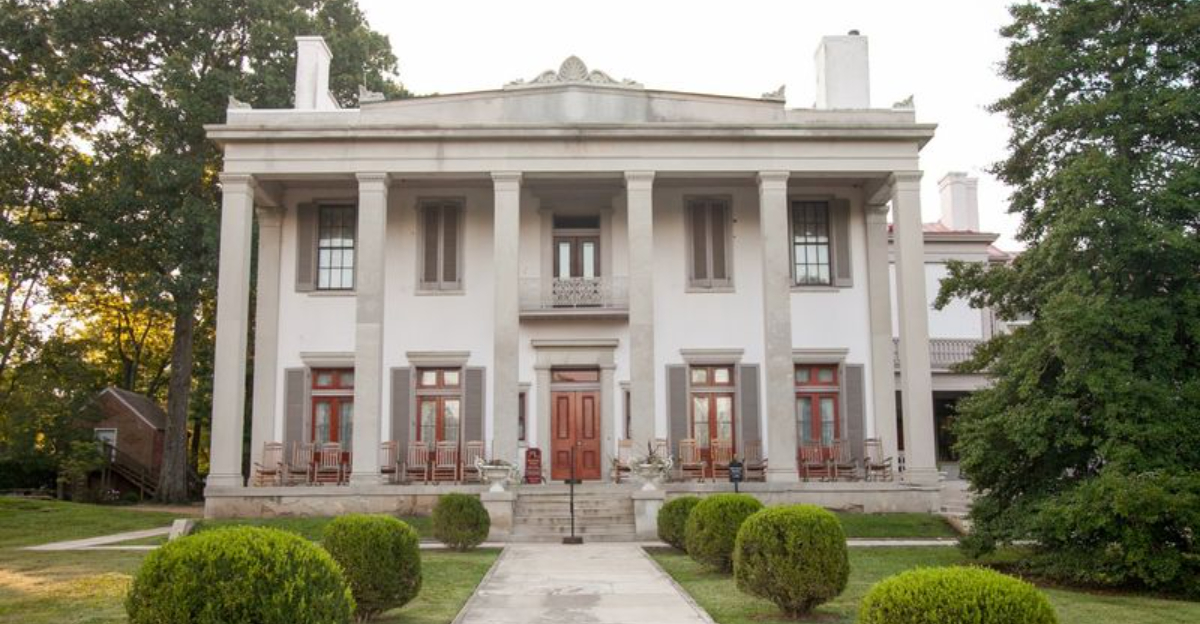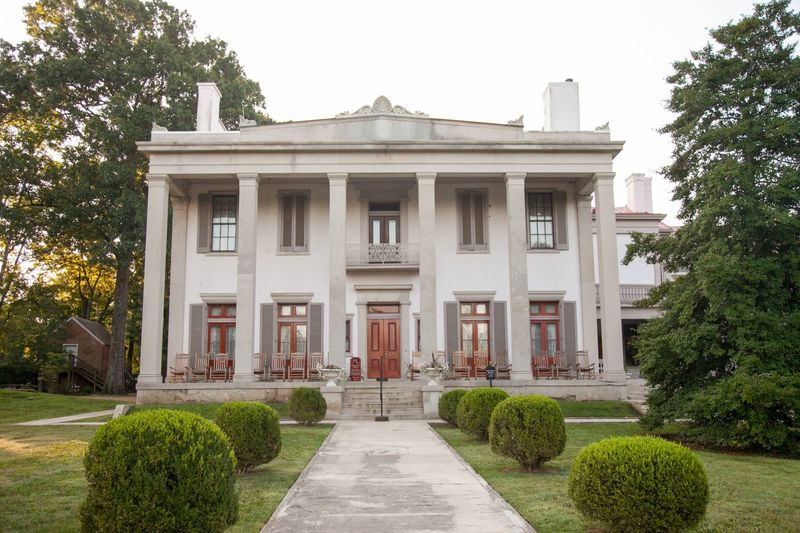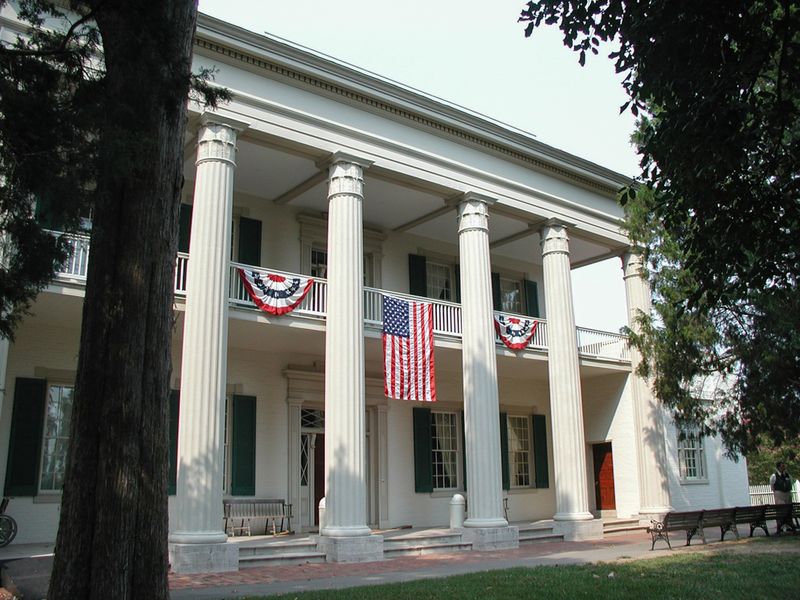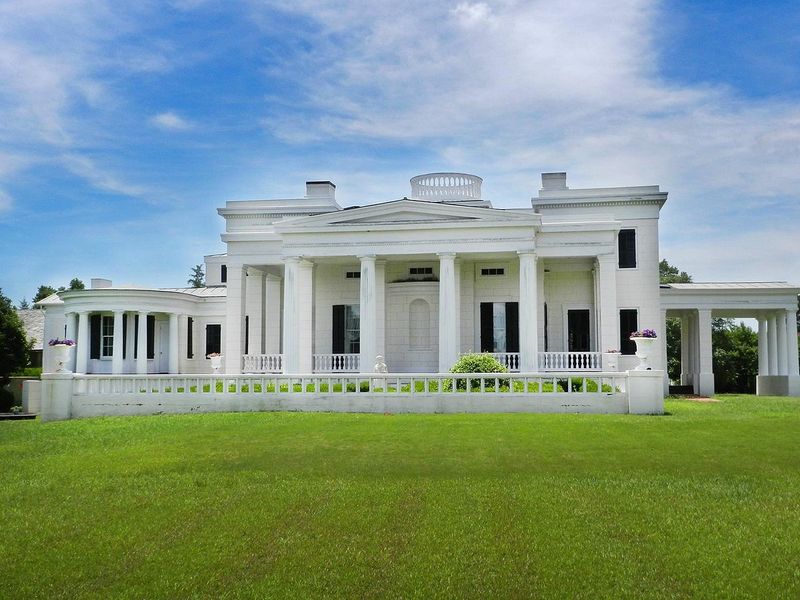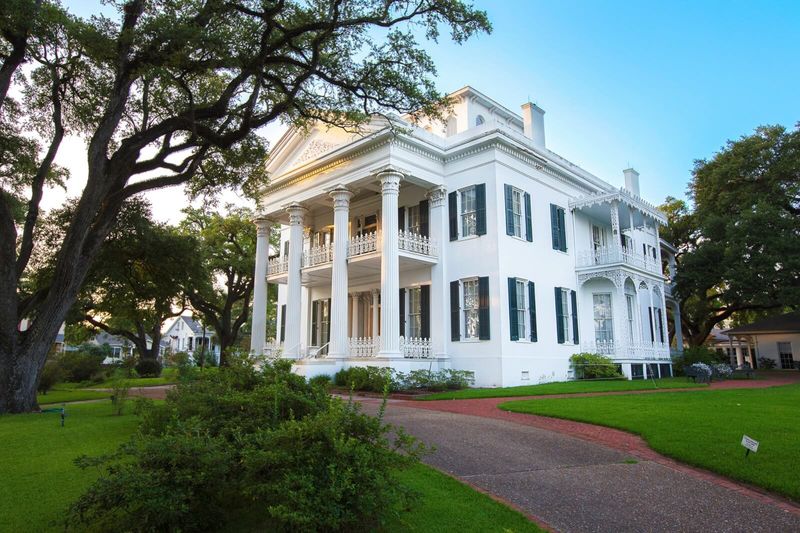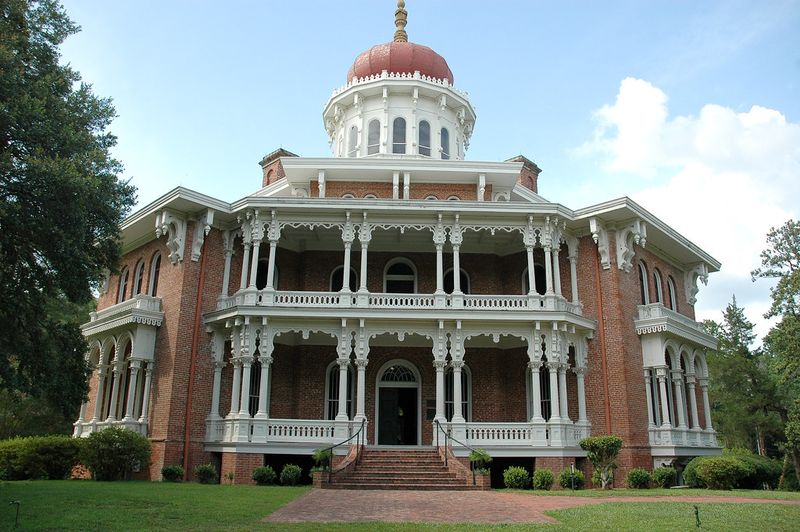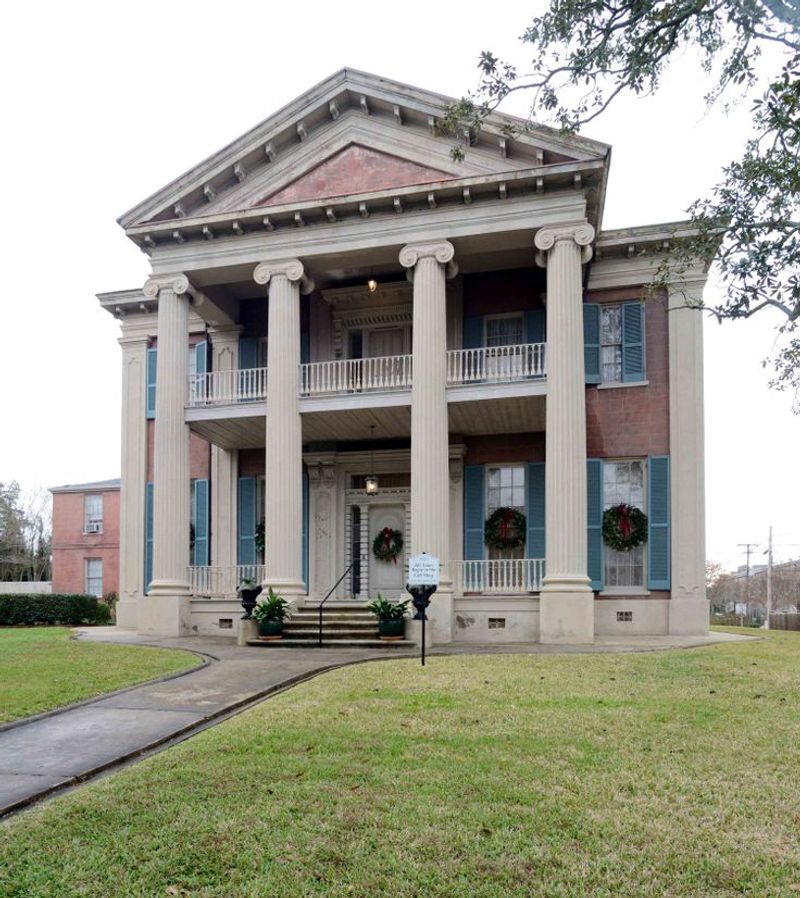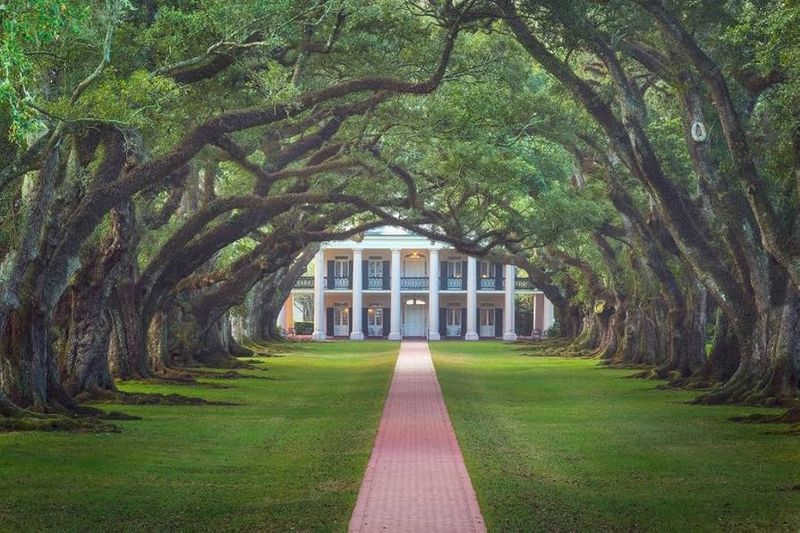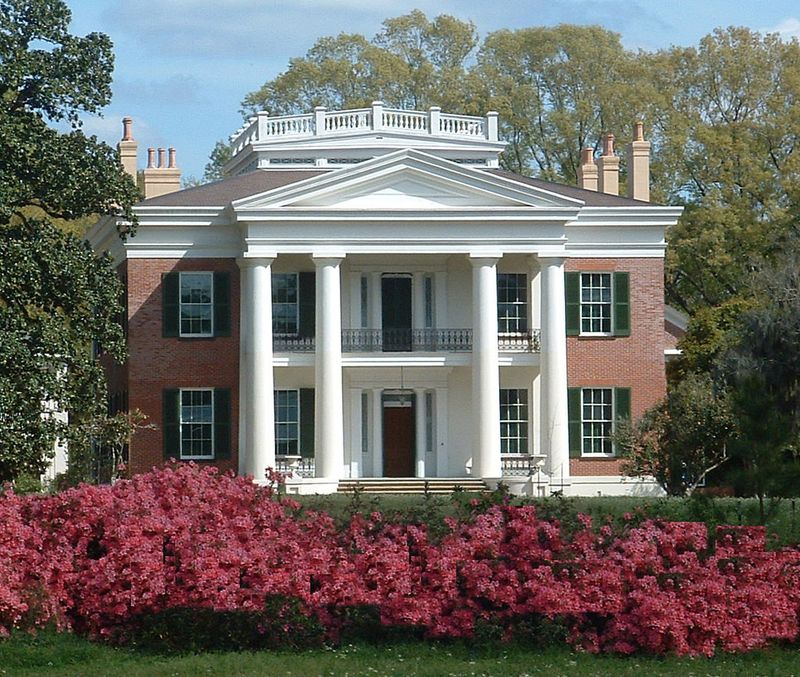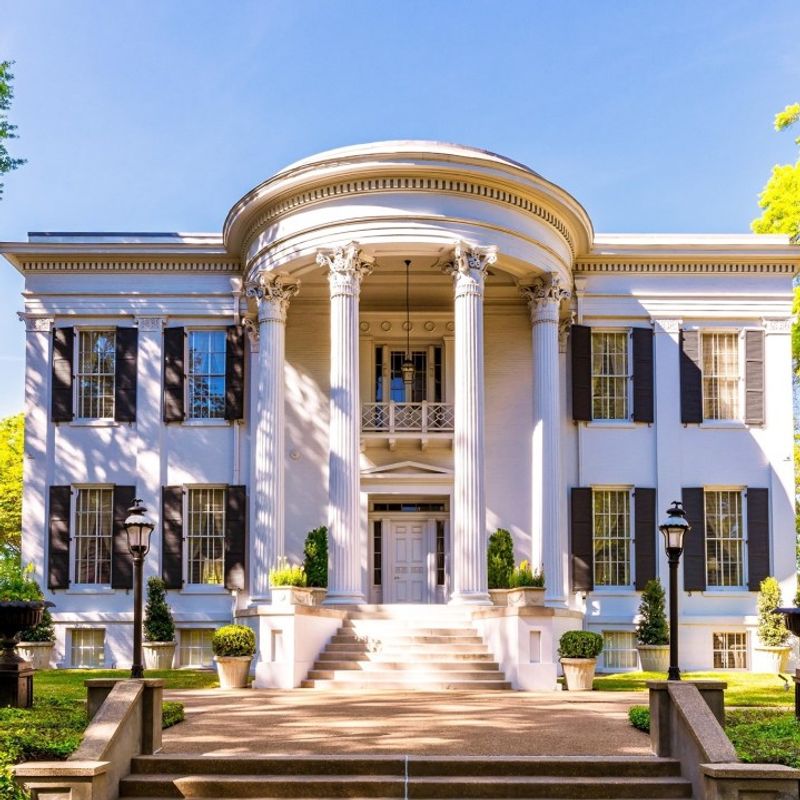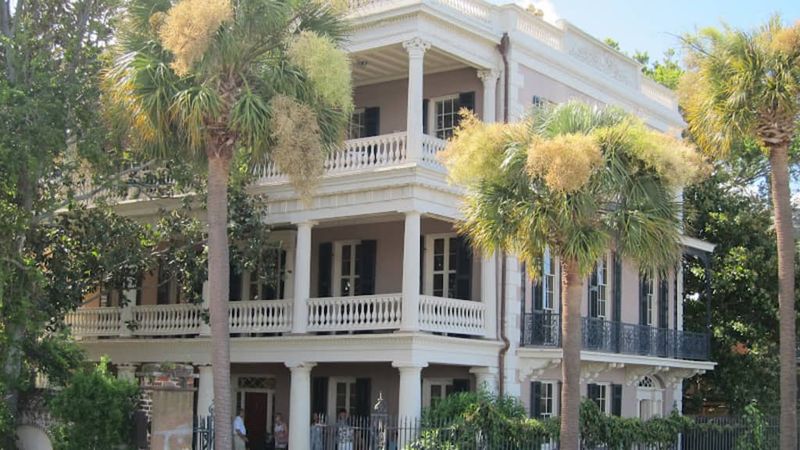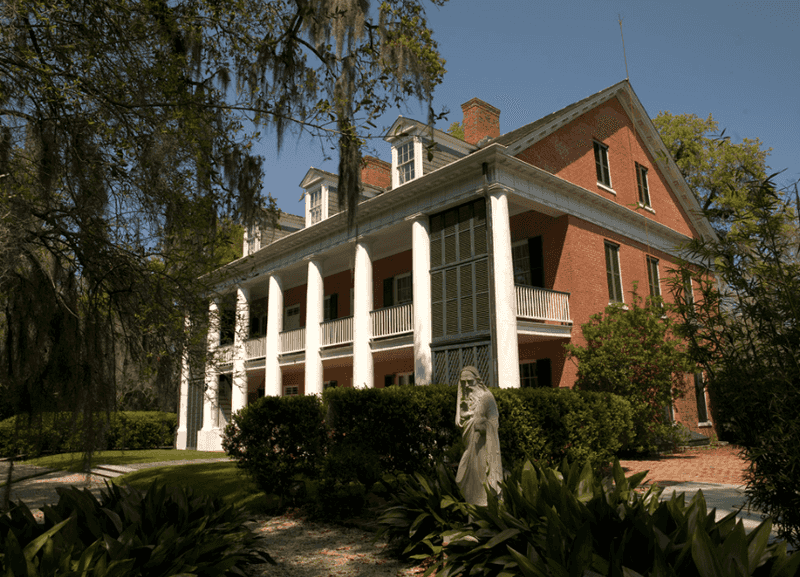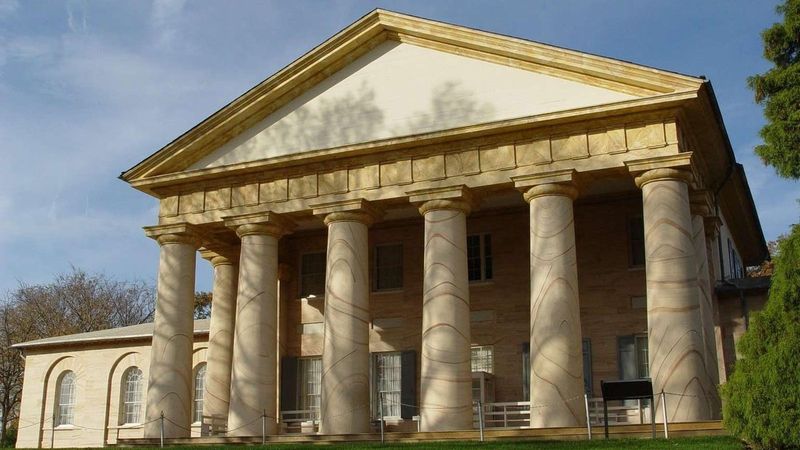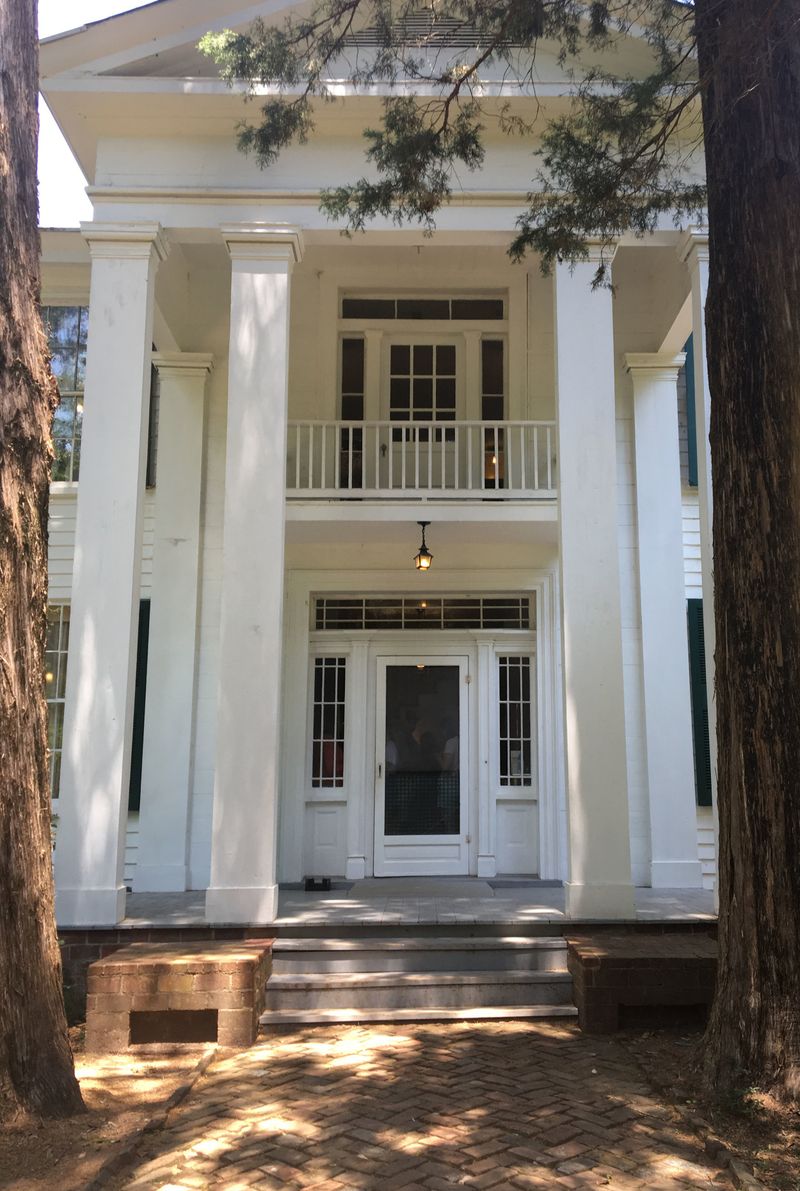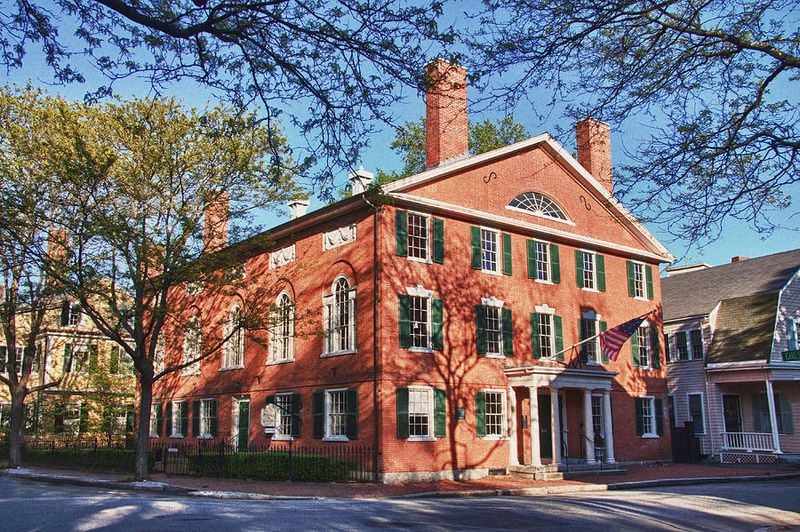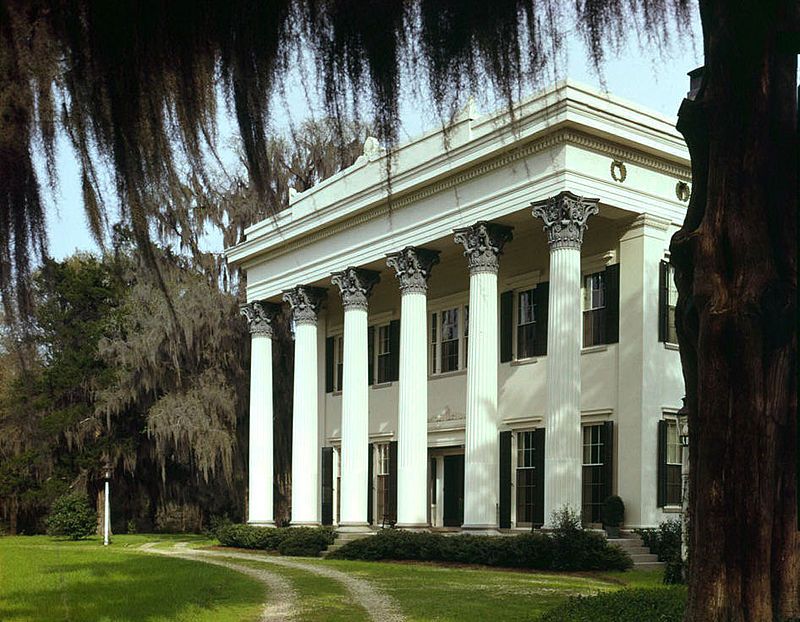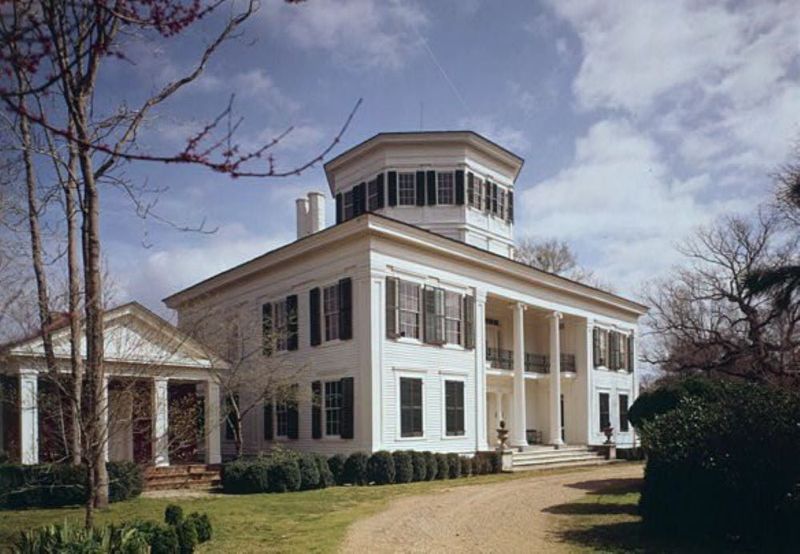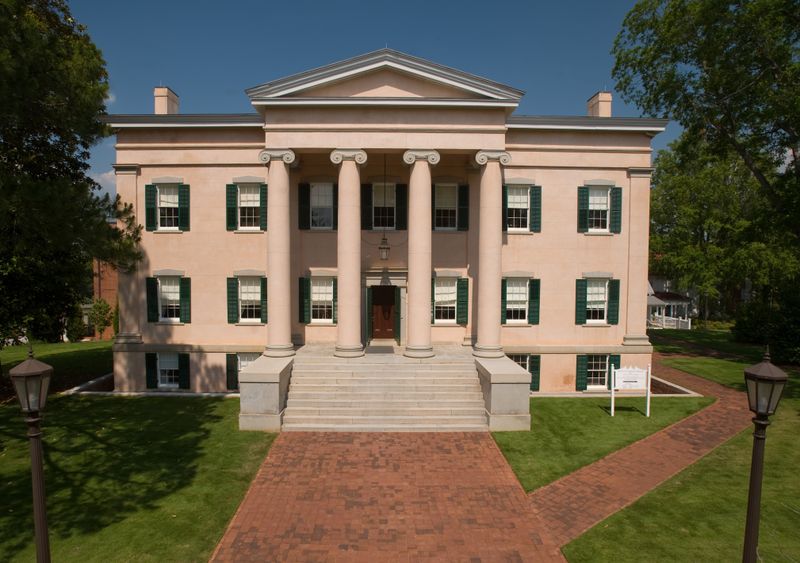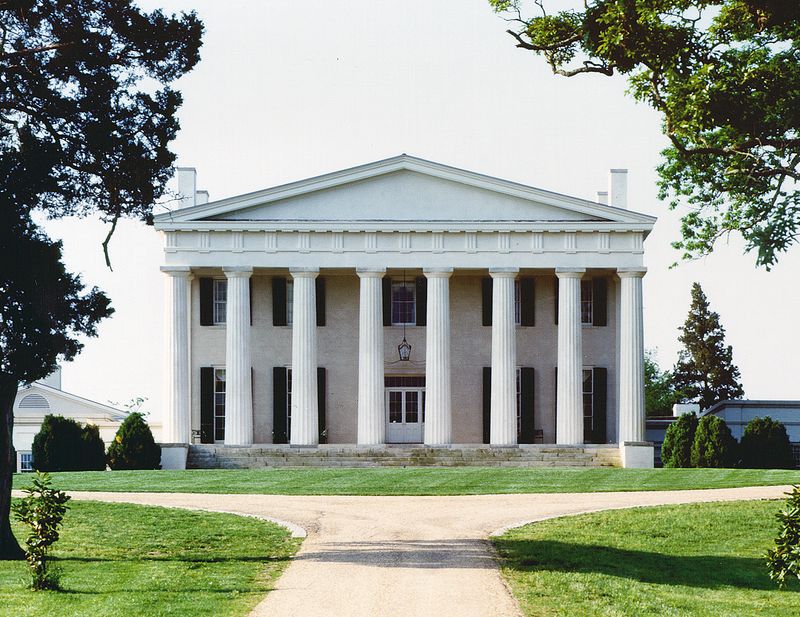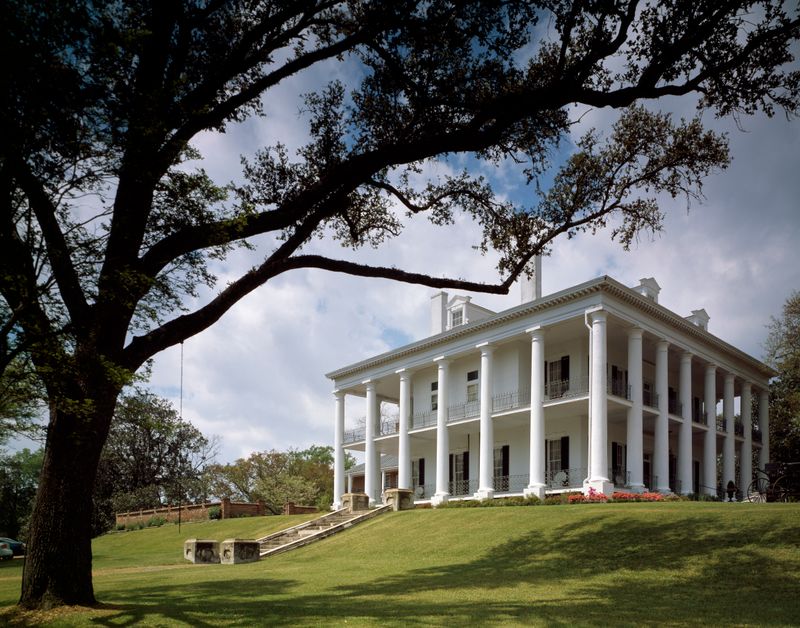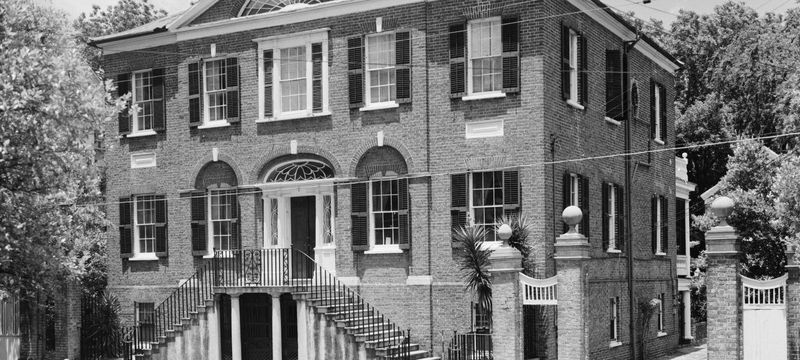Step back in time and marvel at the grand columns and symmetrical designs of Greek Revival architecture, America’s first truly national style.
From the 1820s to the 1850s, these majestic homes dominated the American landscape, bringing ancient Greek temples to the doorsteps of ordinary citizens.
These historical treasures now stand as proud reminders of our nation’s architectural heritage, each with a unique story to tell.
1. Belle Meade Plantation
Nestled in Nashville, Tennessee, this magnificent mansion showcases the grandeur that wealthy Southern plantation owners aspired to achieve. Built in 1853, its imposing six limestone columns create a dramatic entrance that commands attention.
Visitors often gasp upon entering the central hall with its stunning spiral staircase. The home’s symmetrical design, elaborate trim work, and Greek-inspired details make it a textbook example of the style that swept across America.
2. The Hermitage
Would you believe this stately Tennessee home belonged to President Andrew Jackson? Completed in 1821, the mansion underwent a Greek Revival transformation in the 1830s after a devastating fire.
The result? A magnificent structure with six soaring columns supporting a classical pediment. Inside, period furnishings transport visitors back to Jackson’s era. The home’s balanced proportions and dignified appearance perfectly embodied the democratic ideals of the young American republic.
3. Gaineswood
Imagine creating an architectural masterpiece without formal training! That’s exactly what General Nathan Bryan Whitfield did when he built this extraordinary Alabama mansion between 1843 and 1861.
Unlike many Greek Revival homes constructed all at once, Gaineswood evolved over nearly two decades. The result is breathtaking: massive Ionic columns, elaborate plasterwork, and domed ceilings that would impress even ancient Athenians.
The home’s exceptional interior spaces feature some of the finest Greek Revival detailing found anywhere in America.
4. Stanton Hall
Talk about making a statement! This colossal Natchez mansion occupies an entire city block and spared no expense in its construction. Completed in 1857 for cotton merchant Frederick Stanton, it cost the astronomical sum of $83,000 (equivalent to millions today).
Enormous Corinthian columns, ornate ironwork, and marble mantels imported from New York showcase the immense wealth of the antebellum South. Though Stanton only enjoyed his dream home for a few months before his death, his legacy lives on in this spectacular Greek Revival treasure.
5. Longwood
Frozen in time, this unusual octagonal mansion in Natchez, Mississippi tells a poignant story of the Civil War’s impact. Construction began in 1860 for wealthy planter Haller Nutt, but when war erupted in 1861, Northern craftsmen abandoned their tools and fled home.
The exterior was largely completed, but the upper floors remain unfinished to this day. Despite its incomplete state, the home’s Greek Revival elements shine through in its columned entrance and classical proportions. Visitors find the contrast between the finished basement and the skeletal upper floors hauntingly beautiful.
6. Magnolia Hall
Completed just months before the Civil War began, this elegant Natchez home represents the final flowering of Greek Revival architecture in the Deep South. Wealthy merchant Thomas Henderson commissioned this sophisticated residence in 1858.
A visitor’s eye is immediately drawn to the graceful Ionic columns supporting a classical entablature. Inside, elaborate ceiling medallions and intricate plasterwork showcase the skilled craftsmanship of the era.
The home’s perfect proportions and refined details demonstrate how the Greek Revival style had matured into a distinctly American architectural language.
7. Oak Alley Plantation
Few American homes can boast a more dramatic setting than this Louisiana treasure. A quarter-mile canopy of 300-year-old oak trees leads to a picture-perfect Greek Revival mansion completed in 1839.
Twenty-eight massive Doric columns encircle the home, creating a stunning temple-like appearance. The brilliant white structure stands in stark contrast against the lush green landscape. While its beauty is undeniable, Oak Alley also serves as an important historical site that acknowledges the enslaved people whose labor built and maintained this architectural icon.
8. Melrose Plantation
Surrounded by ancient oak trees dripping with Spanish moss, this Natchez jewel exemplifies the refined elegance of high-style Greek Revival architecture. Built between 1841 and 1845 for attorney John McMurran, the home remains remarkably intact with its original furnishings.
A two-story portico with fluted Ionic columns creates an imposing facade. What truly sets Melrose apart is its exceptionally well-preserved complex of dependencies, including a kitchen, dairy, slave quarters, and carriage house.
9. The Governor’s Mansion
Since 1839, this stately Jackson, Mississippi landmark has housed 33 governors and their families. Designed by architect William Nichols, the mansion ranks among America’s second-oldest continuously occupied gubernatorial residences.
Eight towering columns support a simple yet dignified pediment, creating a powerful symbol of state authority. Though relatively modest in size compared to some private Greek Revival mansions, the building’s perfect proportions and brilliant white exterior make it an architectural standout.
10. Edmondston-Alston House
Perched along Charleston’s historic Battery, this sophisticated townhouse offers a distinctive urban interpretation of Greek Revival style. Originally built in 1825 as a Federal-style home, merchant Charles Edmondston transformed it into a Greek Revival showcase in the 1830s.
Unlike rural plantations, this city dwelling adapted classical elements to fit a narrow lot. The piazza (side porch) with its Corinthian columns provides spectacular harbor views.
11. Shadows-on-the-Teche
Beneath towering live oaks draped with Spanish moss sits this atmospheric Louisiana plantation home completed in 1834. Sugar planter David Weeks commissioned this distinctive residence along Bayou Teche, creating a unique Gulf Coast interpretation of the Greek Revival style.
The double galleries (porches) respond perfectly to the hot, humid climate. Amazingly, four generations of the same family occupied the home until 1958, preserving an extraordinary collection of original furnishings and over 17,000 family documents.
12. Arlington House
Standing high above Washington DC, this monumental mansion was home to Robert E. Lee before the Civil War forever changed its destiny. Completed in 1818, it represents an early and influential example of Greek Revival architecture designed by architect George Hadfield.
The massive central portico with eight Doric columns creates one of America’s most recognizable silhouettes. What makes Arlington unique is its use of stuccoed brick painted with sand to mimic stone – a technique called “roughcasting.”
13. Rowan Oak
Literary pilgrims flock to this modest Oxford, Mississippi home where Nobel Prize-winning author William Faulkner lived and worked from 1930 until his death in 1962. The primitive Greek Revival farmhouse, built in the 1840s, features a simple two-story portico with square columns.
What fascinates visitors most is Faulkner’s study, where his outline for “A Fable” remains written in pencil on the wall. The home’s unpretentious character reflects the writer’s connection to his fictional Yoknapatawpha County.
14. Hamilton Hall
Behind an unassuming brick facade lies one of Salem, Massachusetts’ architectural treasures. Designed by famous architect Samuel McIntire in 1805, this Federal-style building incorporates early Greek Revival elements that would soon sweep the nation.
Named for Alexander Hamilton, the hall hosted elegant society gatherings for Salem’s merchant elite. Delicate Corinthian columns and refined plasterwork showcasing classical motifs adorn the spectacular second-floor ballroom.
15. Millford Plantation
Hidden away in rural South Carolina stands what many architectural historians consider America’s finest Greek Revival residence. Completed in 1841 for John Manning, this palatial home features six massive Corinthian columns carved from solid blocks of stone.
Remarkably, the mansion retains most of its original Duncan Phyfe furniture – an extraordinary rarity. The home’s perfect proportions, exceptional craftsmanship, and pristine condition make it a true architectural time capsule.
16. Waverly Mansion
A curious octagonal cupola crowns this unusual Mississippi plantation home, creating one of the South’s most distinctive Greek Revival silhouettes. Built between 1852 and 1856 by George Hampton Young, the mansion combines classical elements with unique personal touches.
Four colossal Corinthian columns support a two-story portico that seems to reach for the sky. What makes Waverly truly special is its extraordinary state of preservation after sitting abandoned for nearly 50 years.
Local legend claims the mansion was haunted during its abandonment, with mysterious piano music often heard from the empty house.
17. The Old Governor’s Mansion
For nearly three decades, this magnificent Milledgeville structure served as home to Georgia’s governors before the capital moved to Atlanta. Completed in 1839, the mansion represents one of the finest High Greek Revival public buildings in America.
Architect Charles Cluskey created a temple-like facade with four fluted Ionic columns and an impressive entablature. During Sherman’s March to the Sea in 1864, the mansion briefly served as Union headquarters – perhaps saving it from destruction.
18. Berry Hill Plantation
Rising dramatically from the Virginia countryside, this colossal mansion resembles an ancient Greek temple more than a private residence. Completed around 1842 for James Coles Bruce, one of Virginia’s wealthiest planters, the home features eight massive Doric columns supporting a classical pediment.
Unlike many Southern plantations, Berry Hill was constructed of solid stone rather than wood or brick with stucco. The mansion’s remarkably intact landscape includes rare surviving slave quarters, providing important historical context.
19. Dunleith
Completely encircled by 26 towering columns, this extraordinary Natchez mansion creates the illusion of a Greek temple floating above the Mississippi landscape. Built in 1856 to replace an earlier home destroyed by fire, Dunleith represents Greek Revival architecture at its most theatrical.
What makes this home unique is its full colonnade surrounding all four sides – a feature rarely seen in American Greek Revival. The columns support a broad gallery that provides outdoor living space while shading the interior from harsh sunlight.
20. William Blacklock House
Tucked away on Charleston’s historic Bull Street, this sophisticated townhouse demonstrates how Greek Revival principles were adapted to urban settings. Completed in 1800, the home incorporates classical elements that predated the full flowering of Greek Revival style.
A curved staircase leads to a second-story piazza supported by Ionic columns – a distinctly Charleston feature that responds brilliantly to the coastal climate. Inside, exceptional woodwork and plasterwork showcase the craftsmanship of skilled artisans, many of whom were enslaved.

